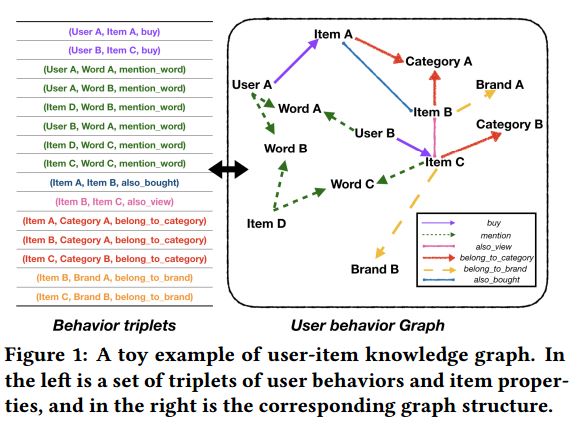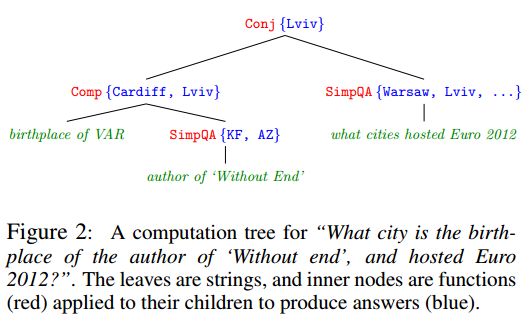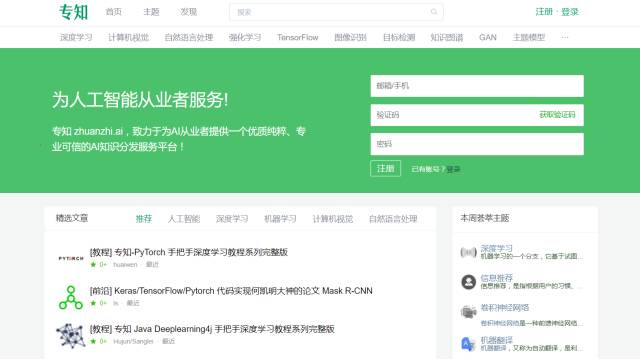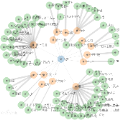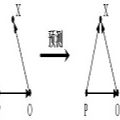【论文推荐】最新六篇知识图谱相关论文—Zero-shot识别、卷积二维知识图谱、变分知识图谱推理、张量分解、推荐
【导读】既昨天推出六篇知识图谱(Knowledge Graph)文章,专知内容组今天又推出最近六篇知识图谱相关文章,为大家进行介绍,欢迎查看!
1. Zero-shot Recognition via Semantic Embeddings and Knowledge Graphs(基于语义嵌入和知识图谱零次识别)
作者:Xiaolong Wang,Yufei Ye,Abhinav Gupta
机构:Carnegie Mellon University
摘要:We consider the problem of zero-shot recognition: learning a visual classifier for a category with zero training examples, just using the word embedding of the category and its relationship to other categories, which visual data are provided. The key to dealing with the unfamiliar or novel category is to transfer knowledge obtained from familiar classes to describe the unfamiliar class. In this paper, we build upon the recently introduced Graph Convolutional Network (GCN) and propose an approach that uses both semantic embeddings and the categorical relationships to predict the classifiers. Given a learned knowledge graph (KG), our approach takes as input semantic embeddings for each node (representing visual category). After a series of graph convolutions, we predict the visual classifier for each category. During training, the visual classifiers for a few categories are given to learn the GCN parameters. At test time, these filters are used to predict the visual classifiers of unseen categories. We show that our approach is robust to noise in the KG. More importantly, our approach provides significant improvement in performance compared to the current state-of-the-art results (from 2 ~ 3% on some metrics to whopping 20% on a few).
期刊:arXiv, 2018年4月9日
网址:
http://www.zhuanzhi.ai/document/bb4696cc3a31fe5e927d9148587c78c5
2. Convolutional 2D Knowledge Graph Embeddings(卷积二维知识图谱嵌入)
作者:Tim Dettmers,Pasquale Minervini,Pontus Stenetorp,Sebastian Riedel
机构:Università della Svizzera italiana
摘要:Link prediction for knowledge graphs is the task of predicting missing relationships between entities. Previous work on link prediction has focused on shallow, fast models which can scale to large knowledge graphs. However, these models learn less expressive features than deep, multi-layer models -- which potentially limits performance. In this work, we introduce ConvE, a multi-layer convolutional network model for link prediction, and report state-of-the-art results for several established datasets. We also show that the model is highly parameter efficient, yielding the same performance as DistMult and R-GCN with 8x and 17x fewer parameters. Analysis of our model suggests that it is particularly effective at modelling nodes with high indegree -- which are common in highly-connected, complex knowledge graphs such as Freebase and YAGO3. In addition, it has been noted that the WN18 and FB15k datasets suffer from test set leakage, due to inverse relations from the training set being present in the test set -- however, the extent of this issue has so far not been quantified. We find this problem to be severe: a simple rule-based model can achieve state-of-the-art results on both WN18 and FB15k. To ensure that models are evaluated on datasets where simply exploiting inverse relations cannot yield competitive results, we investigate and validate several commonly used datasets -- deriving robust variants where necessary. We then perform experiments on these robust datasets for our own and several previously proposed models, and find that ConvE achieves state-of-the-art Mean Reciprocal Rank across all datasets.
期刊:arXiv, 2018年4月6日
网址:
http://www.zhuanzhi.ai/document/d84bc355535b53ec78fa666eec3f83f4
3. Variational Knowledge Graph Reasoning(变分知识图谱推理)
作者:Wenhu Chen,Wenhan Xiong,Xifeng Yan,William Wang
机构:University of California
摘要:Inferring missing links in knowledge graphs (KG) has attracted a lot of attention from the research community. In this paper, we tackle a practical query answering task involving predicting the relation of a given entity pair. We frame this prediction problem as an inference problem in a probabilistic graphical model and aim at resolving it from a variational inference perspective. In order to model the relation between the query entity pair, we assume that there exists an underlying latent variable (paths connecting two nodes) in the KG, which carries the equivalent semantics of their relations. However, due to the intractability of connections in large KGs, we propose to use variation inference to maximize the evidence lower bound. More specifically, our framework (\textsc{Diva}) is composed of three modules, i.e. a posterior approximator, a prior (path finder), and a likelihood (path reasoner). By using variational inference, we are able to incorporate them closely into a unified architecture and jointly optimize them to perform KG reasoning. With active interactions among these sub-modules, \textsc{Diva} is better at handling noise and coping with more complex reasoning scenarios. In order to evaluate our method, we conduct the experiment of the link prediction task on multiple datasets and achieve state-of-the-art performances on both datasets.
期刊:arXiv, 2018年4月6日
网址:
http://www.zhuanzhi.ai/document/8aa7f7843bcf325312cc225e3caf9d6e
4. Knowledge Completion for Generics using Guided Tensor Factorization(使用引导张量分解的泛型知识完成)
作者:Hanie Sedghi,Ashish Sabharwal
摘要:Given a knowledge base or KB containing (noisy) facts about common nouns or generics, such as "all trees produce oxygen" or "some animals live in forests", we consider the problem of inferring additional such facts at a precision similar to that of the starting KB. Such KBs capture general knowledge about the world, and are crucial for various applications such as question answering. Different from commonly studied named entity KBs such as Freebase, generics KBs involve quantification, have more complex underlying regularities, tend to be more incomplete, and violate the commonly used locally closed world assumption (LCWA). We show that existing KB completion methods struggle with this new task, and present the first approach that is successful. Our results demonstrate that external information, such as relation schemas and entity taxonomies, if used appropriately, can be a surprisingly powerful tool in this setting. First, our simple yet effective knowledge guided tensor factorization approach achieves state-of-the-art results on two generics KBs (80% precise) for science, doubling their size at 74%-86% precision. Second, our novel taxonomy guided, submodular, active learning method for collecting annotations about rare entities (e.g., oriole, a bird) is 6x more effective at inferring further new facts about them than multiple active learning baselines.
期刊:arXiv, 2018年3月29日
网址:
http://www.zhuanzhi.ai/document/f2cc0bd98371dce316e67a70bec4359c
5. Learning over Knowledge-Base Embeddings for Recommendation(在知识库嵌入的基础上进行推荐)
作者:Yongfeng Zhang,Qingyao Ai,Xu Chen,Pengfei Wang
机构:Rutgers University,University of Massachuses Amherst
摘要:State-of-the-art recommendation algorithms -- especially the collaborative filtering (CF) based approaches with shallow or deep models -- usually work with various unstructured information sources for recommendation, such as textual reviews, visual images, and various implicit or explicit feedbacks. Though structured knowledge bases were considered in content-based approaches, they have been largely neglected recently due to the availability of vast amount of data, and the learning power of many complex models. However, structured knowledge bases exhibit unique advantages in personalized recommendation systems. When the explicit knowledge about users and items is considered for recommendation, the system could provide highly customized recommendations based on users' historical behaviors. A great challenge for using knowledge bases for recommendation is how to integrated large-scale structured and unstructured data, while taking advantage of collaborative filtering for highly accurate performance. Recent achievements on knowledge base embedding sheds light on this problem, which makes it possible to learn user and item representations while preserving the structure of their relationship with external knowledge. In this work, we propose to reason over knowledge base embeddings for personalized recommendation. Specifically, we propose a knowledge base representation learning approach to embed heterogeneous entities for recommendation. Experimental results on real-world dataset verified the superior performance of our approach compared with state-of-the-art baselines.
期刊:arXiv, 2018年3月23日
网址:
http://www.zhuanzhi.ai/document/4a7f93d4541c08412376c92c7ac72f98
6. The Web as a Knowledge-base for Answering Complex Questions(利用网络作为知识库回答复杂问题)
作者:Alon Talmor,Jonathan Berant
机构:Tel-Aviv University
摘要:Answering complex questions is a time-consuming activity for humans that requires reasoning and integration of information. Recent work on reading comprehension made headway in answering simple questions, but tackling complex questions is still an ongoing research challenge. Conversely, semantic parsers have been successful at handling compositionality, but only when the information resides in a target knowledge-base. In this paper, we present a novel framework for answering broad and complex questions, assuming answering simple questions is possible using a search engine and a reading comprehension model. We propose to decompose complex questions into a sequence of simple questions, and compute the final answer from the sequence of answers. To illustrate the viability of our approach, we create a new dataset of complex questions, ComplexWebQuestions, and present a model that decomposes questions and interacts with the web to compute an answer. We empirically demonstrate that question decomposition improves performance from 20.8 precision@1 to 27.5 precision@1 on this new dataset.
期刊:arXiv, 2018年3月18日
网址:
http://www.zhuanzhi.ai/document/877232e5fa767722b5d1277cd822a82e
-END-
专 · 知
人工智能领域主题知识资料查看获取:【专知订阅】人工智能知识资料全集与专知AI知识技术服务群
请PC登录www.zhuanzhi.ai或者点击阅读原文,注册登录专知,获取更多AI知识资料!
请扫一扫如下二维码关注我们的公众号,获取人工智能的专业知识!
请加专知小助手微信(Rancho_Fang),加入专知主题人工智能群交流!加入专知主题群(请备注主题类型:AI、NLP、CV、 KG等)交流~
投稿&广告&商务合作:fangquanyi@gmail.com
点击“阅读原文”,使用专知




